In many systems, transition networks are used to describe a set of states
and the transitions that are possible between them. Common examples are such
things as ATM control flows, editorial review processes, and definitions of
protocol states. Typically, each of these transition networks has it's own
specific data format, and it's own specific editing tool. Given the rapid
transition to pervasive networking, and to application integration and
interchange, a standard format for transition networks is desirable. This
document defines such an interchange format, defined in XML: the interchange
language for the Internet.
Status of This Document
This document is one component of a submission request to the World Wide Web Consortium from
eBusiness Technologies, Inc. (see Submission
Request, W3C Staff Comment). For
a full list of all acknowledged Submissions, please see Acknowledged Submissions to W3C.
This document is a Note made available by W3C for discussion only. This
work does not imply endorsement by, or the consensus of the W3C membership,
nor that W3C has, is, or will be allocating any resources to the issues
addressed by the Note. This document is a work in progress and may be updated,
replaced, or rendered obsolete by other documents at any time.
This document is submitted to the W3C in the hope that it will serve an
educational and advisory role for future efforts.
Should any changes be required to the document, we would expect future
versions to be produced by the W3C process. eBT maintains ownership of the
XTND specification and reserves the right to maintain and evolve the XTND
specification independently and such independent maintenance and evolution
shall be owned by eBT.
A list of current W3C technical documents can be found at the Technical Reports page.
People often talk about processes; a sequence of events that have occurred. Typical descriptive sentences
will be of the form "First this happens, then
this happens. After that, if this condition is true,
that happens". For communicative purposes between people,
such sentences suffice, but for computers, a more formal approach is needed.
One such formalism is the notion of a transition
network.
Loosely speaking, a transition network is a set of states and the
transitions between them. As noted above, they are good at capturing the
notion of process. For example:
- Control processes such as those in a digitally controlled heating
system.
- Processes controlling manufacture or design.
- Workflow processes such as those found in product data management
software.
They are also useful in modeling the behavior of systems and can be used in
object-oriented analysis to create formal models of object interaction and
larger system behavior.
Transition networks are closely related to finite state
machines(FSM) , and to data flow diagrams(DFD), but
they are augmented with the following capabilities:
- Transition networks are not limited to "accepting or rejecting their
input". Transition networks may execute actions or
fire off events during transitions.
- Transition networks can interact with other objects, thereby affecting
change in the transition network (or in other networks).
- Transitions in transition networks can be controlled by guard conditions
that prohibit or allow the transition to be followed.
- These guard conditions can be dependent on any predicate involving
objects from within the environment of the transition network.
As such, transition networks can be used to describe far more complex
interactions or processes than either FSMs or DFDs allow.
A state within a transition network can loosely be defined as a point
between transitions. In transition network diagrams, a state is typically
depicted as a circle containing the name of the state, as show below.
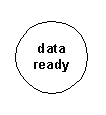
Depiction of the "data ready" state
While states are a point between transitions, there are some advantages to
dealing with them explicitly:
- Talking about states forms part of normal conversion. For example,
people say, "my engine is off" meaning that the engine is in the off
state. The principals of natural design call for states to be modeled
explicitly.
- There can often be multiple transitions into, and more importantly, out
of, a state. As such, states can represent a branch
in a process.
- In some transition network formalisms, entry and exit from states can
also execute actions and generate events.
Typically states are defined in terms of the attributes of an object, or
objects in the system. For example, one would say that water has a number of
states:
- Frozen - when the temperature of the water is less than 0 degrees.
- Cold - when the temperature is less than 32 degrees.
- Hot - when the temperature is greater than 80 degrees.
- Boiled - when the temperature is greater than 100 degrees.
One might also have the state "normal" as defined below.
- Normal - The state is not Frozen, Cold, Hot or Boiled.
The important point about the last example is that it shows one of the
requirements of states: that they be exclusive. An object, or system, cannot
be in two states at once.
In many processes, there is the notion of continuum, which is not
completely captured by the above definition of state. For example, we have the
notion of "thawing", where the word implies an ongoing, and active state that is continually altering the system. This
will be discussed further in the section on transitions.
Even though the process may allow entry and exit from multiple states, when
describing the execution of a process, there is always a beginning, and an
end. Transition networks, likewise, require start and ending states. Start and
end states can be defined as follows:
- Start state - a state that, in the context of a given execution, has no
transitions preceding entry into the state.
- End state - a state that has no transitions out of the state (no forward transitions).
For the rest of this paper, the following two symbols will be used.
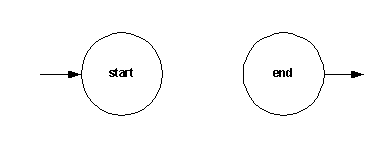
Start and End state diagrams.
Note that this differs from traditional data flow diagram symbols.
A transition is an atomic, directed connection between one state and
another. Typically transitions are represented as a line connecting two
states. The following is a simple example.
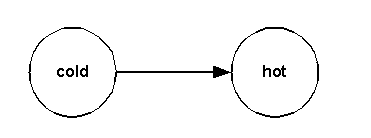
Sample transition from "cold" to "hot"
Bi-directional transitions (transitions both from a to b and b to a) are
typically modeled as two separate transitions.
Transitions can be defined implicitly by the exclusionary nature of states:
when the conditions defining one state become false, and the conditions for
another true, there is an implicit transition from one state to another; this
model has only limited applicability however.
An active state can be looked upon as a state that is being continually
updated, or a gradual transitionfrom one state to another. As
such, active states can be looked upon as a form of continually evaluated
transition.
While using transitions to model active states does not capture the full
semantics (because they are atomic, and not continually updated), for most
purposes this model suffices to capture the distinction.
Note that in fact it is often useful to think at an even finer level of
granularity, and break transitions down into 3 discrete steps that form an
atomic action. Those steps are:
- Leaving a state - the point at which the state has been left, but
traversal of the transition between states has not yet begun.
- Transitioning between states - the act of traversing the transition
between states.
- Entering a state - the point at which the new state is entered, but
before the "resting point" has been reached.
These 3 steps can, of course, be decomposed into a transition network.
The main thing separating transition networks from FSM is their active
nature. This is captured in the notion of conditions, actions, and events.
In order to control the set of transitions that are possible within a
transition network, it is necessary to introduce the notion of a condition . Essentially a condition is a set of predicates
that guard entry to and/or exit from a given state. In
other words, conditions filter the set of possible transitions.
In some systems, the conditions are placed solely on the transitions
themselves, in others conditions can be placed upon states as a precondition
to entry. These are essentially the same thing, and are not mutually
exclusive: in a system allowing both, the union of the guard conditions on the
transition and the preconditions on the state form the total set of conditions
to be met (i.e. this is an implicit "and" combination of the predicates).
Likewise, it is possible to have postconditions on a state controlling the
ability to transition from a state.
Given the above, there are three types of conditions found in transition
network systems:
- State preconditions - conditions that guard entry into a state.
- State postconditions - conditions that guard exit from a state.
- Transition preconditions - conditions guarding the transition from one
state to another.
In transition networks actions , or operations , allow processing to be associated with a
transition. Typically such actions will involve simple interaction with
objects in the environment of the transition (getting and setting properties
typically), though any arbitrary processing can be performed within the
context of the environment. One rule must be obeyed however: altering the
environment such that the guard conditions would now fail, should not result
in the transition failing. Transitions must always be regarded as atomic.
Typically, actions are associated with the transition, but it is often
desirable to be able to specify actions at each of the three steps involved in
making a transition. As such, there are three sets of actions that can be
invoked:
- State postlude - the set of actions associated with the exit from a
state.
- Transition body - the set of actions associated with transition
traversal.
- State prelude - the set of actions associated with the entry into a
state.
Actions are scoped to the environment in which they are executed, and so
they can only affect local state. Events , or messages, represent the interaction of the transition
network with objects outside the local scope. Typically, they are modeled as
actions that have the ability to send an event.
In order to capture conditions and actions in a diagram (again, events are
modeled as actions capable of sending an event), we must augment the symbols
given above. The augmented version shown below will be used throughout the
rest of this document.
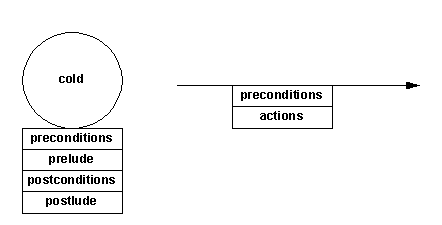
Augmented symbols for representing conditions and
actions
Transition networks form a graph, and XML is hierarchical, so there would
appear to be some discord between the two models. This is not the case if a
transition network is seen as a set of states, and a set of transitions: these
sets can be easily marked up in XML. Following the practice of natural design
leads to a fairly natural mapping from this view of a transition network to
its XML representation. This section describes that mapping.
From the explanations in the introduction, states can be modeled as objects
with the following type:
state = object {
name = string;
preconditions = set of predicates;
prelude = ordered set of actions;
postconditions = set of predicates;
postlude = ordered set of actions;
};
Translating this into XML yields a simple element definition as shown
below.
<!ELEMENT state (properties?,
preconditions?,
prelude?,
postlude?,
postconditions?) >
<!ATTLIST state id ID #REQUIRED
name CDATA #REQUIRED >
The properties, preconditions, postconditions,
prelude and postlude elements are defined elsewhere.
The 2 main things to note about this definition of a state are:
- The id attribute - this is declared as an ID attribute
to guarantee that the state identifier is unique throughout the transition
network definition.
- The name attribute - provides a descriptive name for the
state.
Like states, the introduction provides the basis for deriving an object
type for transitions. A transition can be modeled as:
transition = object {
from = oid;
to = oid;
preconditions = set of predicates;
actions = ordered set of actions;
};
Translating the object into XML once again yields a straightforward element
definition, as shown below.
<!ELEMENT transition (properties?,
preconditions?,
actions?) >
<!ATTLIST transition id ID #REQUIRED
name CDATA #REQUIRED
from IDREF #REQUIRED
to IDREF #REQUIRED
mode (auto|manual) #REQUIRED>
As for state definitions, the properties, preconditions,
and actions elements are defined elsewhere.
The main things to note about this element definition are:
- The id attribute - this is declared as an ID attribute
to guarantee that the transition identifier is unique throughout the
transition network definition.
- The name attribute - provides a descriptive name for the
transition.
- The to and from attributes - these form the connection
between states. They are defined as IDREF attributes so that they
are constrained to reference the id attribute of a state (though
this constraint is cannot be enforced by the DTD alone).
- The mode attribute - this states whether the transition should
be taken automatically if the set of conditions allows it. If this is set
to auto, the transition will be taken automatically, if it is set
to manual, an event of some sort will be needed to force the
transition.
One of the great challenges in using transition networks is modeling
actions. Typically, behavior in systems is defined in a procedural manner
rather than declaratively: in other words, actions are defined in terms of
how they are to be performed, rather than
what effect the actions will have. This is largely because,
as yet, purely declarative systems that can model complex interactions remain
a research problem.
As such, the approach taken here to use an expression language defined in
XML, but to model behavior at a coarse level rather than a fine-grained
procedural level. As an example, rather than specifying how an event is sent,
a <send-event> expression would be defined. Within the context
of a given application, these coarse-grained actions, if defined well, can be
seen as declarative, and a degree of static analysis becomes possible.
The language chosen here is the XEXPR language, an example of which
follows.
<set name="AA" value="AA Value"/>
<print newline="true"><get name="AA"/></print>
In the element definitions for states and transitions, a number of other
elements were defined. There declarations follow:
<!ELEMENT preconditions (%expression;)*>
<!ELEMENT postconditions (%expression;)*>
<!ELEMENT prelude (%expression;)*>
<!ELEMENT postlude (%expression;)*>
<!ELEMENT actions (%expression;)*>
They all use a list of expressions. For conditions, expressions are
restricted to predicates. The use of a parameter entity makes it easy to
extend the set of possible expressions as the XEXPR language allows elements
to be bound to expressions, meaning that the base DTD may not model all
elements in the definition.
The following is the complete set of definitions from the DTD for XTND
along with explanatory prose.
<!DOCTYPE xtnd [
<!ENTITY % def.prop PUBLIC "-//EBT//ELEMENTS Property Set//EN">
%def.prop;
<!ENTITY % def.expr PUBLIC "-//EBT//ELEMENTS XML Expression Language//EN">
%def.expr;
This starts the DTD, and pulls in two DTD modules: the property and
expression definitions. The public identifier for the DTD is "-//EBT//DTD
Transition Network//EN"
<!ELEMENT preconditions (%expression;)*>
<!ELEMENT postconditions (%expression;)*>
Preconditions and postconditions are simply a set of predicates
(expressions that evaluate to a Boolean result). The expression
parameter entity is defined in the def.expr module.
<!ELEMENT xtnd (properties?,
definitions?,
states,
transitions?)>
<!ELEMENT definitions (define*)>
A transition network can optionally have an arbitrary set of properties
associated with it that, depending on the application, could either be used as
metadata, or form part of the execution environment of the objects in the
system.
In addition, a transition network can optionally have a set of definitions.
This is simply a list of <define> expressions from the XEXPR
language that allow elements to be bound to expressions for use in actions.
See the XEXPR specification for more detail.
The heart of the transition network is made up of a required set of states,
and an optional set of transitions.
<!ELEMENT states (state+)>
<!ATTLIST states start IDREF #REQUIRED>
<!ELEMENT state (properties?,
preconditions?,
prelude?,
postlude?,
postconditions?)>
<!ATTLIST state id ID #REQUIRED
name CDATA #REQUIRED>
<!ELEMENT prelude (%expression;)*>
<!ELEMENT postlude (%expression;)*>
The set of states is simply a list of <state> elements. Each
state must have a unique ID attribute and a descriptive name
attribute. As part of the state, each state can have an optional set of
preconditions, an optional set of postconditions, an optional prelude, and an
optional postlude. All of these can contain a list of expressions.
There must be a single start state defined in the network, identified by
the start attribute on the <states> element.
<!ELEMENT transitions (transition*) >
<!ELEMENT transition (properties?,
preconditions?,
actions?) >
<!ATTLIST transition id ID #REQUIRED
name CDATA #REQUIRED
from IDREF #REQUIRED
to IDREF #REQUIRED
mode (auto|manual) #REQUIRED>
<!ELEMENT actions (%expression;)* >
The set of transitions is an optional, possibly empty list of
<transition> elements defining how states can be connected.
The following are a few examples of transition networks marked up using
XTND. As can be seen, the modeling is fairly natural and intuitive in
practice.
The following shows the transition network for a door, which can have only
two states: open and closed. The door can transition from
open, to closed, and from closed to open.
The door starts off in the open state.
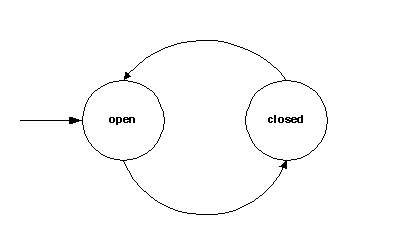
Simple transition network for a door
This simple transition network can be straightforwardly marked up in XTND
as follows.
<xtnd>
<states start="open">
<state id="open" name="Opened State"/>
<state id="closed" name="Closed State"/>
</states>
<transitions>
<transition id="open-close"
name="Transition from opened to closed"
from="open"
to="closed"
mode="manual"/>
<transition id="close-open"
name="Transition from closed to opened"
from="closed"
to="open"
mode="manual"/>
</transitions>
</xtnd>
Note that the mode attribute for both the open and
closed states are set to manual. If these were set to
auto, it would imply the door opening and closing ad infinitum! As it
is, some event must cause the transition.
The above can be augmented with actions. In the diagram below we show that
an action is associated with the prelude of each state, and with the
transitions between states.
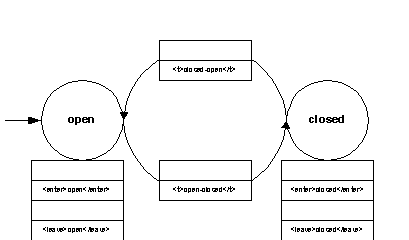
Transition network with actions
This can also easily be represented in the XML form, as shown below.
<xtnd>
<definitions>
<define name="enter" args="x">
<print>Entering <x/>...</print>
</define>
<define name="leave" args="x">
<print>Leaving <x/>...</print>
</define>
<define name="t" args="x">
<print>Transitioning <x/>...</print>
</define>
</definitions>
<states start="open">
<state id="open" name="Opened State">
<prelude><enter>open</enter></prelude>
<postlude><leave>open</leave></postlude>
</state>
<state id="closed" name="Closed State">
<prelude><enter>closed</enter></prelude>
<postlude><leave>closed</leave></postlude>
</state>
</states>
<transitions>
<transition id="open-close"
name="Transition from opened to closed"
from="open"
to="closed"
mode="manual">
<actions><t>open-closed</t></actions>
</transition>
<transition id="close-open"
name="Transition from closed to opened"
from="closed"
to="open"
mode="manual">
<actions><t>closed-open</t></actions>
</transition>
</transitions>
</xtnd>
This example also shows the use of definitions, which implies that the
expression DTD has also been updated to encompass the defined elements.
The namespace for XTND is
http://www.ebt.com/xtnd
People using this namespace are encouraged to use the xtnd
namespace prefix.
The public identifier for the XTND DTD is
-//EBT//DTD Transition Network/EN
The following is the DTD fragment for properties in the XTND DTD.
<!ENTITY % properties "properties">
<!ELEMENT properties (property*)>
<!ELEMENT property (#PCDATA)>
<!ATTLIST property
name CDATA #REQUIRED
type (int|float|boolean|
string|object) #REQUIRED>
The constraints placed on the format of the object values are as
follows:
- int
- [+\-]?[0-9]+
- float
- [+\-]? [0-9]+.[0-9]+[+-][eE][0-9]+
- boolean
- true|false
- string
- Any sequence of characters legal as PCDATA. CDATA
sections may also be used to escape the textual content.
- object
- The exact format is application dependent. In Java
this might be a BASE64 encoded form of the serialized object.
The public identifier for this fragment is
-//EBT//ELEMENTS Property Set//EN
The following is a DTD fragment for expressions in the XTND DTD. Note that
this will need to be extended for each element defined using the
<define> function.
<!ENTITY % expression "bind|define|get|set
|expr|add|subtract|multiply
|divide|string|integer|float
|true|false|nil|eq|neq|leq
|geq|lt|gt|and|or|not|if
|switch|do|while|print
|println">
<!ELEMENT bind EMPTY>
<!ATTLIST bind class CDATA #REQUIRED
name CDATA #IMPLIED>
<!ELEMENT define (%expression;)*>
<!ATTLIST define name CDATA #REQUIRED
args CDATA #IMPLIED>
<!ELEMENT get EMPTY>
<!ATTLIST get name CDATA #REQUIRED>
<!ELEMENT set (%expression;)*>
<!ATTLIST set name CDATA #REQUIRED>
<!ELEMENT expr (%expression;)*>
<!ELEMENT add (%expression;)*>
<!ELEMENT subtract (%expression;)*>
<!ELEMENT multiply (%expression;)*>
<!ELEMENT divide (%expression;)*>
<!ELEMENT string (#PCDATA)>
<!ELEMENT integer (#PCDATA)>
<!ELEMENT float (#PCDATA) >
<!ELEMENT true EMPTY>
<!ELEMENT false EMPTY>
<!ELEMENT nil EMPTY>
<!ELEMENT eq (%expression;)*>
<!ELEMENT neq (%expression;)*>
<!ELEMENT leq (%expression;)*>
<!ELEMENT geq (%expression;)*>
<!ELEMENT lt (%expression;)*>
<!ELEMENT gt (%expression;)*>
<!ELEMENT and (%expression;)*>
<!ELEMENT or (%expression;)*>
<!ELEMENT not (%expression;)*>
<!ELEMENT if (%expression;)*>
<!ELEMENT switch (case*) >
<!ELEMENT case (%expression;)*>
<!ELEMENT do (%expression;)*>
<!ELEMENT while (%expression;)*>
<!ELEMENT print (#PCDATA|%expression;)*>
<!ATTLIST print newline (true|false) #IMPLIED>
<!ELEMENT println (#PCDATA|%expression;)*>
The public identifier for this fragment is
-//EBT//ELEMENTS XML Expression Language//EN
- Action
- An operation associated with a state transition that
interact with objects in the environment of the transition network.
- Active State
- A state that represents a continuum of behavior. For
example closing the door represents an active
state.
- Condition
- A predicate controlling the ability to transition
from one state to another.
- End State
- A state that has no forward transitions
possible.
- Event
- An action that is sent outside the local environment
of the transition network. Events are one means of having transition
networks affect larger system state.
- Data Flow Diagrams
- A diagramming technique showing how data flows
through a set of states.
- Finite State Machines
- An abstract machine that is made from a set of
states and transitions between then. FSMs are typically said to "match
their input" in the set of input results in no transitions to error
states. Unlike transition networks, FSMs do not explicitly provide the
notion of actions.
- Forward Transition
- A transition out of a given state.
- Guard
- A predicate controlling the ability to transition
from one state to another. See Condition.
- Message
- An action that is sent outside the local environment
of the transition network. See Event.
- Operation
- Something associated with a transition that allows
the transition network to define interaction with it's environment.
- Passive State
- A state which, when entered, is fully transitioned
into.
- Preconditions
- A set of conditions controlling entry into a state,
or the traversal of a transition.
- Prelude
- A set of actions executed upon entry into a
state.
- Postconditions
- A set of conditions controlling whether it is
possible to leave a state.
- Postlude
- A set of action executed when a state is
exited.
- Process
- A form of state transition network.
- Static State
- A state which, when entered, is fully transitioned
into. See Passive State.
- Transition Network
- A network of states and the transitions between
them. Unlike FSMs, transition networks describe actions that can occur
in the network.
- XTND
- An XML definition of a transition network. XTND is
pronounced "eXTeND".
The following is a list of recommended reading.
- Diagramming Techniques for Analysts and Programmers
- J. Martin and C. McClure
- Object Oriented System Development
- Dennis de Chapeaux, Douglas Lea, Penelope Faure
- XML 1.0
- http://www.w3.org/XML





